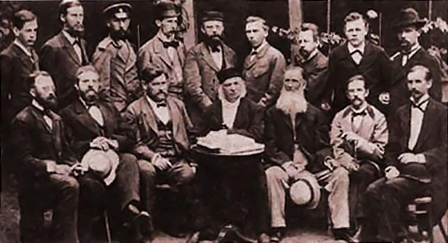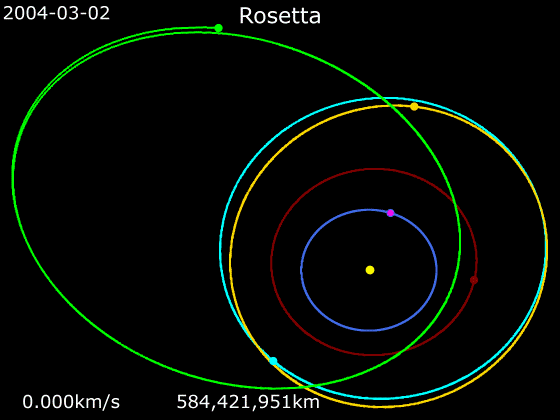|
Kārlis Šteins
Kārlis Šteins (October 13, 1911 – April 4, 1983) was a Latvian and Soviet astronomer and populariser of this science. Biography Šteins was born on October 13, 1911 in Kazan, Russian Empire. In 1925 he finished the Riga 2nd Secondary school. In 1929 he started the studies in University of Latvia, the Faculty of Mathematics and Natural Science. In 1934 he graduated from the University of Latvia. In 1933 he was practicing in Kraków, Poland, at Kraków Astronomical Observatory under supervision of Tadeusz Banachiewicz, and continued there until 1936. In 1933 he calculated the orbit of asteroid 1933 OP, discovered by Karl Wilhelm Reinmuth, and named it 1284 Latvia; this is the first minor planet to bear a Latvia-related name. After 1951 he worked at the University of Latvia as professor at the department of Theoretical Physics. He became an associate professor (docent) in 1956, and professor in 1966. He became a member of the IAU in 1958, and of the Astronomy council of the USSR ... [...More Info...] [...Related Items...] OR: [Wikipedia] [Google] [Baidu] |
Latvia
Latvia ( or ; lv, Latvija ; ltg, Latveja; liv, Leţmō), officially the Republic of Latvia ( lv, Latvijas Republika, links=no, ltg, Latvejas Republika, links=no, liv, Leţmō Vabāmō, links=no), is a country in the Baltic region of Northern Europe. It is one of the Baltic states; and is bordered by Estonia to the north, Lithuania to the south, Russia to the east, Belarus to the southeast, and shares a maritime border with Sweden to the west. Latvia covers an area of , with a population of 1.9 million. The country has a temperate seasonal climate. Its capital and largest city is Riga. Latvians belong to the ethno-linguistic group of the Balts; and speak Latvian, one of the only two surviving Baltic languages. Russians are the most prominent minority in the country, at almost a quarter of the population. After centuries of Teutonic, Swedish, Polish-Lithuanian and Russian rule, which was mainly executed by the local Baltic German aristocracy, the independent R ... [...More Info...] [...Related Items...] OR: [Wikipedia] [Google] [Baidu] |
Pulkovo Observatory
The Pulkovo Astronomical Observatory (russian: Пулковская астрономическая обсерватория, Pulkovskaya astronomicheskaya observatoriya), officially named the Central Astronomical Observatory of the Russian Academy of Sciences at Pulkovo, is the principal astronomical observatory of the Russian Academy of Sciences. It is located 19 km south of Saint Petersburg on Pulkovo Heights above sea level. It is part of the UNESCO World Heritage Site Historic Centre of Saint Petersburg and Related Groups of Monuments. It was formerly known as the Imperial Observatory at Pulkowo. Early years The observatory was opened in 1839. Originally, it was a brainchild of the German/Russian astronomer Friedrich Georg Wilhelm von Struve, who would become its first director (in 1861, his son Otto Wilhelm von Struve succeeded him). The architect was Alexander Bryullov. The observatory was equipped with state-of-the-art devices, one of them being the a aperture ref ... [...More Info...] [...Related Items...] OR: [Wikipedia] [Google] [Baidu] |
Soviet Astronomers
This list of Russian astronomers and astrophysicists includes the famous astronomers, astrophysicists and cosmologists from the Russian Empire, the Soviet Union and the Russian Federation. Alphabetical list __NOTOC__ A *Tateos Agekian, one of the pioneers of Russian and world Stellar dynamics, discoverer of two evolutionary sequences of stellar systems: nearly spherical and strongly flattened *Vladimir Albitsky, discovered a significant number of asteroids *Viktor Ambartsumian, one of the founders of theoretical astrophysics, discoverer of stellar associations, founder of Byurakan Observatory in Armenia *Andrejs Auzāns, director of the Tashkent observatory, 1911-1916 B *Nikolai P. Barabashov, co-author of the ground breaking publication of the first pictures of the far side of the Moon in 1961, called ''Atlas of the Other Side of the Moon''; a crater and a planet were named after him *Vladimir Belinski, an author of the BKL singularity model of the Universe evolution *Igor ... [...More Info...] [...Related Items...] OR: [Wikipedia] [Google] [Baidu] |
Latvian Astronomers
Latvian may refer to: *Something of, from, or related to Latvia **Latvians, a Baltic ethnic group, native to what is modern-day Latvia and the immediate geographical region **Latvian language, also referred to as Lettish **Latvian cuisine **Latvian culture **Latvian horse *Latvian Gambit, an opening in chess See also *Latvia (other) Latvia is a country in Europe. Latvia can also refer to: *Latvian Soviet Socialist Republic (1940–1990) *Latvia (European Parliament constituency) * 1284 Latvia - asteroid * Latvia Peak - mountain in Tajikistan Tajikistan (, ; tg, То� ... * {{disambiguation Language and nationality disambiguation pages ... [...More Info...] [...Related Items...] OR: [Wikipedia] [Google] [Baidu] |
Latvian Scientists
Latvian may refer to: *Something of, from, or related to Latvia **Latvians, a Baltic ethnic group, native to what is modern-day Latvia and the immediate geographical region **Latvian language, also referred to as Lettish **Latvian cuisine **Latvian culture **Latvian horse *Latvian Gambit, an opening in chess See also *Latvia (other) Latvia is a country in Europe. Latvia can also refer to: *Latvian Soviet Socialist Republic (1940–1990) *Latvia (European Parliament constituency) *1284 Latvia - asteroid *Latvia Peak - mountain in Tajikistan Tajikistan (, ; tg, Тоҷ� ... * {{disambiguation Language and nationality disambiguation pages ... [...More Info...] [...Related Items...] OR: [Wikipedia] [Google] [Baidu] |
Scientists From Kazan
A scientist is a person who conducts scientific research to advance knowledge in an area of the natural sciences. In classical antiquity, there was no real ancient analog of a modern scientist. Instead, philosophers engaged in the philosophical study of nature called natural philosophy, a precursor of natural science. Though Thales (circa 624-545 BC) was arguably the first scientist for describing how cosmic events may be seen as natural, not necessarily caused by gods,Frank N. Magill''The Ancient World: Dictionary of World Biography'', Volume 1 Routledge, 2003 it was not until the 19th century that the term ''scientist'' came into regular use after it was coined by the theologian, philosopher, and historian of science William Whewell in 1833. In modern times, many scientists have advanced degrees in an area of science and pursue careers in various sectors of the economy such as academia, industry, government, and nonprofit environments.'''' History The roles ... [...More Info...] [...Related Items...] OR: [Wikipedia] [Google] [Baidu] |
1983 Deaths
The year 1983 saw both the official beginning of the Internet and the first mobile cellular telephone call. Events January * January 1 – The migration of the ARPANET to TCP/IP is officially completed (this is considered to be the beginning of the true Internet). * January 24 – Twenty-five members of the Red Brigades are sentenced to life imprisonment for the 1978 murder of Italian politician Aldo Moro. * January 25 ** High-ranking Nazi war criminal Klaus Barbie is arrested in Bolivia. ** IRAS is launched from Vandenberg AFB, to conduct the world's first all-sky infrared survey from space. February * February 2 – Giovanni Vigliotto goes on trial on charges of polygamy involving 105 women. * February 3 – Prime Minister of Australia Malcolm Fraser is granted a double dissolution of both houses of parliament, for elections on March 5, 1983. As Fraser is being granted the dissolution, Bill Hayden resigns as leader of the Australian Labor Party, and in the subsequ ... [...More Info...] [...Related Items...] OR: [Wikipedia] [Google] [Baidu] |
1911 Births
A notable ongoing event was the race for the South Pole. Events January * January 1 – A decade after federation, the Northern Territory and the Australian Capital Territory are added to the Commonwealth of Australia. * January 3 ** 1911 Kebin earthquake: An earthquake of 7.7 moment magnitude strikes near Almaty in Russian Turkestan, killing 450 or more people. ** Siege of Sidney Street in London: Two Latvian anarchists die, after a seven-hour siege against a combined police and military force. Home Secretary Winston Churchill arrives to oversee events. * January 5 – Egypt's Zamalek SC is founded as a general sports and Association football club by Belgian lawyer George Merzbach as Qasr El Nile Club. * January 14 – Roald Amundsen's South Pole expedition makes landfall, on the eastern edge of the Ross Ice Shelf. * January 18 – Eugene B. Ely lands on the deck of the USS ''Pennsylvania'' stationed in San Francisco harbor ... [...More Info...] [...Related Items...] OR: [Wikipedia] [Google] [Baidu] |
Springer Verlag
Springer Science+Business Media, commonly known as Springer, is a German multinational publishing company of books, e-books and peer-reviewed journals in science, humanities, technical and medical (STM) publishing. Originally founded in 1842 in Berlin, it expanded internationally in the 1960s, and through mergers in the 1990s and a sale to venture capitalists it fused with Wolters Kluwer and eventually became part of Springer Nature in 2015. Springer has major offices in Berlin, Heidelberg, Dordrecht, and New York City. History Julius Springer founded Springer-Verlag in Berlin in 1842 and his son Ferdinand Springer grew it from a small firm of 4 employees into Germany's then second largest academic publisher with 65 staff in 1872.Chronology ". Springer Science+Business Media. In 1964, Springer expanded its business internationally, o ... [...More Info...] [...Related Items...] OR: [Wikipedia] [Google] [Baidu] |
Rosetta Spacecraft
''Rosetta'' was a space probe built by the European Space Agency launched on 2 March 2004. Along with ''Philae'', its lander module, ''Rosetta'' performed a detailed study of comet 67P/Churyumov–Gerasimenko (67P). During its journey to the comet, the spacecraft performed flybys of Earth, Mars, and the asteroids 21 Lutetia and 2867 Šteins. It was launched as the third cornerstone mission of the ESA's Horizon 2000 programme, after ''SOHO'Cluster'' and ''XMM-Newton''. On 6 August 2014, the spacecraft reached the comet and performed a series of manoeuvers to eventually orbit the comet at distances of . On 12 November, its lander module ''Philae'' performed the first successful landing on a comet, though its battery power ran out two days later. Communications with ''Philae'' were briefly restored in June and July 2015, but due to diminishing solar power, ''Rosetta'' communications module with the lander was turned off on 27 July 2016. On 30 September 2016, the ''Rosetta'' sp ... [...More Info...] [...Related Items...] OR: [Wikipedia] [Google] [Baidu] |
Nikolai Stepanovich Chernykh
Nikolai Stepanovich Chernykh (russian: Никола́й Степа́нович Черны́х) (6 October 1931 – 25 May 2004Казакова, Р.К. Памяти Николая Степановича Черных'. Труды Государственного астрономического института им. П.К. Штернберга, Т. 78, М., 2005. – 115 с.) was a Russian-born Soviet astronomer and discoverer of minor planets and comets at the Crimean Astrophysical Observatory in Nauchnyy, Crimea. Biography and work Chernykh was born in the Russian city of Usman in Voronezh Oblast, in present-day Lipetsk Oblast. He specialized in astrometry and the dynamics of small bodies in the Solar System and worked at the Crimean Astrophysical Observatory from 1963. Chernykh discovered two periodic comets 74P/Smirnova–Chernykh and 101P/Chernykh. He also discovered a very large number of asteroids, including notably 2867 Šteins and the Trojan asteroid 2207 Antenor. ... [...More Info...] [...Related Items...] OR: [Wikipedia] [Google] [Baidu] |
2867 Šteins
2867 Šteins (provisional designation ) is an irregular, diamond-shaped background asteroid from the inner regions of the asteroid belt, approximately in diameter. It was discovered on 4 November 1969 by Soviet astronomer Nikolai Chernykh at the Crimean Astrophysical Observatory in Nauchnij on the Crimean peninsula. In September 2008, ESA's spacecraft ''Rosetta'' flew by ''Šteins'', making it one of few minor planets ever visited by a spacecraft. The bright E-type asteroid features 23 named craters and has a rotation period of 6.05 hours. It was named for Soviet Latvian astronomer Kārlis Šteins. Orbit and classification ''Šteins'' is a non-family asteroid from the main belt's background population. It orbits the Sun in the inner asteroid belt at a distance of 2.0–2.7 AU once every 3 years and 8 months (1,327 days; semi-major axis of 2.36 AU). Its orbit has an eccentricity of 0.15 and an inclination of 10 ° with respect to the ecliptic. The body's observa ... [...More Info...] [...Related Items...] OR: [Wikipedia] [Google] [Baidu] |





.png)
